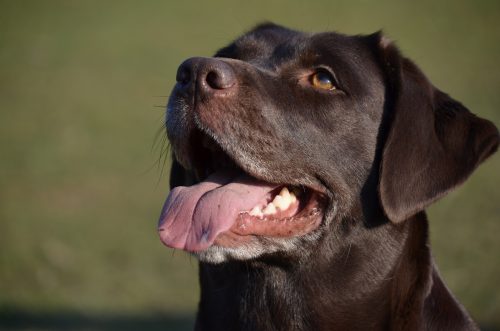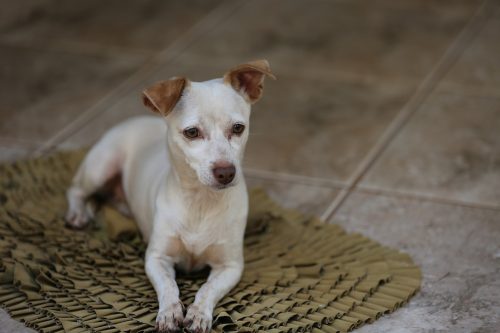Many dog owners have encountered hotspots with their furry friend, but as a first time dog owner, it is hard to know how to recognize them. Hotspots are a form of dermatitis that develops on the surface of the skin and irritates your dog, causing him to persistently lick or scratch the affected area.
However, if you have never seen a hotspot before, you may find yourself asking what do hotspots on dogs look like? The first step to diagnosing, treating, and preventing hotspots in dogs is to understand how to identify what a hotspot looks like.
Physical Appearance of a Hotspot
When identifying a hotspot, it is vital that you understand what you are looking for. Hotspots can appear anywhere on a dog’s body, but despite the variance in location, hotspots generally always look similar. A hotspot is a raw area on the skin that can be distinguished by raw, red skin.
You will notice that your dog will begin to lick the affected area and chew on it in his attempt to alleviate the itching and pain. The affected area will often be red in hue and may appear swollen depending on the severity of the hotspot. For many hotspots, the dog will experience hair loss in the affected area. Hot spots on dogs often begin small, but can grow to six to seven inches wide when left untreated. For some dogs, the appearance of oozing areas or sores will also be a physical demarcation of the presence of a hotspot.
How Hotspots Are Formed

Canine hotspots are lesions that form on the surface of the skin due to a skin infection. Hotspots are also referred to as moist dermatitis or pyotraumatic dermatitis, and are characterized by an area of the skin that has become infected and inflamed due to the presence of a skin infection.
Hotspots are sometimes also called moist eczema or summer sores, as they are much more likely to develop during the warmer, summer months. Hotspots can occur due to a number of different factors. Below are the most common causes of hotspots on dogs:
Allergic Reactions
Many people do not know that the majority of dogs have some kind of allergy, and when they have an allergic reaction it can sometimes result in a hotspot. When your dog is suffering from an allergic reaction, he may be feeling extremely itchy and uncomfortable, causing him to lick and gnaw at the affected area.
Poor Grooming
Poor grooming can lead to a number of extremely negative consequences for a dog, one of them being a hotspot. Hotspots thrive on warm, wet areas where bacteria can form, so if a dog is not being bathed, brushed, and cared for properly, their chance of developing hotspots increases exponentially.
Underlying Skin or Ear Infections
Many dogs suffer from chronic skin or ear infections, and when a dog has an infection, his immune system is weakened as it tries to fight the infection. Due to the compromised immune system, bacteria and secondary infections can form quickly, causing a dog to itch and excessively lick the affected area, resulting in a hotspot.
In addition to this, the presence of a weakened immune system in dogs allows mite and flea populations to skyrocket on the skin’s surface as the dog’s immune system cannot combat them, which can lead to mange in dogs, allergic reactions to fleas, and hotspots as an unfortunate byproduct.

Flea, Mite, or Insect Bites
In response to the presence of flea, mite, or insect bites, many dogs will lick and chew on the affected area. This continuous process of licking and chewing will leave the skin moist and raw, making it form into a hotspot quickly, and only increasing the dog’s discomfort due to the flea, mite, or insect bites.
Matted Hair
Matted hair is the result of a lack of grooming and can result in skin that is exposed to bacteria and moisture retained in the matted hair. As the moisture and bacteria are introduced to the skin, hotspots will often form and leave your dog feeling uncomfortable and itchy.
Mange
Mange is a parasitic skin infection that results from the presence of mites on the skin’s surface. There are several different types of mange, including demodectic and sarcoptic, and both leave the dog feeling itchy, irritated, and unhappy.
If there is an overpopulation of mites on the surface of the skin, your dog will likely try to lick and chew at the skin to get rid of the mites, which will result in the formation of the hotspot. In addition, the presence of mange signifies a weakened immune system, making your dog more susceptible to the formation of a hotspot.
Anal Gland Infection
Anal gland infections are not often mentioned, but are a common ailment for dogs. This infection is often a symptom of a larger issue that your dog is having, such as a common allergy or skin infection. Anal gland infections can also develop when the anal glands are not properly expressed over a period of time, which results in bacteria building up.
Dogs often express their own anal glands when they defecate, but when an anal gland infection occurs, this is not possible. Anal gland infections can also weaken the dog’s immune system, making the probability of forming a hotspot increase.
Bacteria
This is the most common trigger for the development of a hotspot. As your dog’s skin accumulates moisture, it becomes more irritated and bacteria will take hold. This can result in the skin itching and burning, which in turn, causes the hotspot to develop.
Symptoms of Hotspots on Dogs
Hotspots appear in a round shape and look like a raw lesion. They can often be found on the head, paws, sides of the chest, and hips. Hotspots will appear moist and inflamed, and often the hair will fall out or be chewed off in the affected area. Below is a list of the most common symptoms associated with hotspots:
- Hair loss
- Matted, wet fur
Odor emanating from the lesion
- Inflammation, swelling, and redness that is confined to a localized area of the skin
- Dry skin that may appear scabby
- Oozing sores
- Crusted scabs
- Painful, itchy patch of skin
- Persistent itching, chewing, and gnawing at a localized patch of the skin
- Depression (due to the pain and discomfort of the hotspot)
- Abnormal aggression (due to the pain and discomfort of the hotspot)
How to Diagnose a Hotspot

Hotspots are capable of mimicking other canine skin infections and issues, so it is important to visit a veterinarian to correctly diagnose a hotspot. If you believe your dog is suffering from a hotspot, the first step to getting a diagnosis is to make an appointment with your veterinarian. Once at your veterinarian’s office, they will conduct a physical examination.
Hotspots appear similarly to some fungal infections, so your veterinarian may choose to do a blood test or take a swab of the affected area to rule fungal infections out as a possible cause of the irritation. To rule this out, the veterinarian will examine the swab they take under a microscope. In addition to identifying if the affected area is in fact a hotspot, your veterinarian will also work to determine the root cause of the inflamed area.
Where the hotspots appear can sometimes be an indicator of the cause. For example, if the hotspots are covering the external surface of the ear, then the likely cause is an ear infection. However, not all causes are this easy to determine. Some dogs may be developing their hotspots in response to a larger allergic reaction they are experiencing, which may require blood tests to properly identify.
Fleas are another common cause of a hotspot, so it is likely that your veterinarian will comb your dog to check for the presence of live fleas or mites. Once your dog has been diagnosed with a hotspot, the next step is identifying the best form of treatment.
Treatments Options for Hotspots on Dogs
The main focus of treating hotspots must be on treating both the affected area, as well as the root cause of the hotspot. Hotspots are often first treated by trimming the fur surrounding the affected area. This allows air to dry out the affected area. Once the affected area is exposed, it is thoroughly cleaned and a topical treatment is applied to the surface. Two of the most common topical treatments used to treat hotspots are chlorhyexidine and betadine.
Depending on the severity of the infection in the affected area, antibiotics may also be prescribed. The level of inflammation must also be assessed at this time and the veterinarian will determine whether anti-inflammatory antibiotics are also necessary to heal the affected area. Glucocorticoids are one of the most frequently suggested forms of treatment. Hydrocortisone treatment is also often administered, most likely in a spray format. These treatments will prevent the affected area from becoming inflamed.
As mentioned above, treating the affected area is only one part to successfully treating a hotspot. Depending on the underlying cause of the hot spot, the treatment will be different. For dogs suffering from allergies, the veterinarian must determine what they are allergic too, often through a blood test.
Once this is determined, it can be removed from their diet or environment accordingly. If the hotspot is due to poor grooming, a veterinarian will often groom the dog at the office and advise the owner on proper grooming practices to prevent recurrence in the future. If the cause is an underlying ear or skin infection, then the dog will often receive an allergy shot, antibiotics, or both in order to successfully treat the underlying infection.
If the hotspot is due to mite, insect, or flea bites, then the veterinarian will determine which is present and how to best rid the dog of them to prevent future bites. This may be through an oral medication, a medicated shampoo, or both.

For dogs suffering from matted hair, the matted hair will need to be removed and the dog properly groomed in order for the hotspot to properly heal. If a dog has developed mange, then he will likely need to be treated with a topical treatment, medicated bath, and possibly antibiotics or a medicated dip to rid the skin of mites.
To treat an anal gland infection, the veterinarian will express the anal glands, and depending upon the severity of the infection, they may need to flush the gland with a medicated solution and prescribe antibiotics.
If the root cause is bacteria, then the area will need to be thoroughly cleaned and monitored to ensure it is kept dry and clean. Depending on the severity of the bacteria, it may be necessary to prescribe oral antibiotics. With these various treatments in mind, it is important to consider the ways in which you can prevent you dog from developing hotspots.
Tips to Prevent Hotspots on Dogs
While it is not always possible to prevent the formation of a hotspot, there are a number of measures you can take to ward off hotspots before they develop. One of the best ways to prevent hotspots is to keep your dog groomed, clean, and free of matted hair. This will prevent the breeding ground for hotspot formation from being present, which will greatly reduce the likelihood that a hotspot will form.
In addition to this, it is important to be mindful when your dog develops a cut or scrape. When your dog has a cut or scrape, it is vital that you keep moisture from accumulating in the affected area as this will prevent bacteria from forming. To do this, keep any wounds that occur free from dirt and ensure they are dry.
A best practice is to clean the area twice daily and monitor it closely. If hotspots are a recurring issue with your dog, there is most likely an underlying cause that is the root of the problem. If this is the case, it is important to schedule an appointment with your veterinarian to determine the underlying issue.




